Where to go in Switzerland on a short trip: Alps, lakes, and cities
Switzerland is an extremely popular country for those planning multi-stop tours around Europe, yet very few potential first-time visitors actually know specifically where they want to go. Everyone seems to know that it has the most beautiful views of the Alps and some very impressive cities, but there are actually many misconceptions among casual trip planners, so I’d like to clear most of that up below. The places to visit in Switzerland are not obvious until you’ve been there yourself or done many hours of research, so the list below should be a short cut.
I get hundreds if not thousands of itinerary questions for people who are considering a Eurail trip around Europe, and most people just include the word “Switzerland” among a list of cities like Paris, Rome, and Berlin that they want to visit. So where in Switzerland should you go if you can only make a few stops at most? I’ll answer that question below. You’ll mostly want to focus on the best choices for Swiss Alps trips, which I’ll go over below.
Note: This article was expanded and updated in February, 2024.
Switzerland is about outdoor views rather than city visits
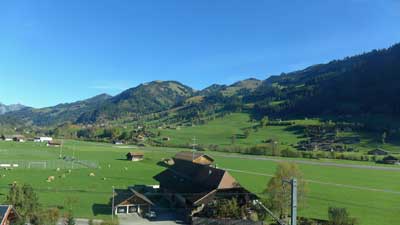
Geneva is a very famous city (though not for tourism reasons) on a lovely lake of the same name, but it’s also notoriously dull and lacking distinction. Rick Steves puts it well by saying that “Geneva is pleasantly situated on a lake, like Buffalo or Cleveland.” The point is, you don’t want to go to Geneva unless you’ve got something specific in mind that you want to see there. There are much better places to visit in Switzerland if your time is limited, or even if it’s not.
Switzerland's cities in summary
Zurich – The largest city, very expensive, geared towards business travelers. It’s generally a pretty and very well-run city that you would enjoy if you visited, but it’s not nearly as interesting as the likes of Vienna, Munich, or of course Paris.
Geneva – Second largest city, in the French part of the country, no major sights. Again, if you visited you’d be very impressed by it and get some great photos, but it’s not worth your time unless you know someone there. There’s an impressive fountain in the lake and you can usually see it from the train as you go through the city, but it’s not really worth going there and staying more than an hour or so.
Basel – Bordering France and Germany, no major sights. It has the famous art market each year, and aside from that it’s even duller than the ones above. Again, if you visited you’d be impressed, but if you later compared photos with friends who went to the Lauterbrunnen Valley instead, you’d kick yourself for going to Basel.
Lausanne – Near Geneva in the French part of the country, very hilly, and certainly more interesting than Geneva.
Bern – The capital, compact, on a lovely river, some interesting sights and the best Swiss city to get a feel for the culture. Bern is fairly close to Interlaken (which we will discuss below) and it can be a great day trip from there, especially on a day where it is foggy and/or rainy in the mountains (and this happens a LOT).
How much time and which Swiss cities to visit?
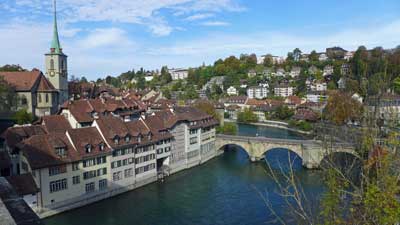
Many people (me included) don’t feel as if they’ve scratched the surface of a new country if they haven’t spent at least a day or two in the largest city. Zurich is certainly pleasant and a useful transit hub so spending one or two nights there wouldn’t be a major mistake. But Zurich isn’t even close to being a city like Paris, Rome, Berlin, Amsterdam, or even Vienna. If you skip it in favor of spending more time in the Swiss Alps, you won’t be missing much.
The 2 Best places to visit in Switzerland for short visits
Interlaken – If you want the best possible Alpine views and activities, head to the Interlaken area, which will be described in detail below. This is my favorite of all places to visit in Switzerland and it will probably be yours as well.
Lucerne – The traditional Swiss tourist retreat, Lucerne is a small city with interesting culture and sights, that is gorgeously set on a lake with plenty of top activities surrounding it.
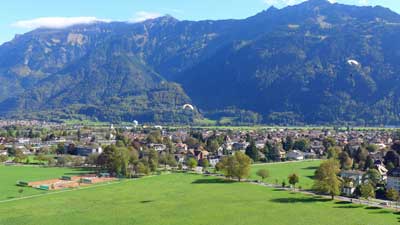
>>>Interlaken and Lucerne: Which to choose and how long to stay in each?
The article linked above will give you more details on which to choose and how long to spend in each place.
What about Zermatt for Alpine views?
Zermatt is a remote car-free village in southern Switzerland that is famous for being the place to see the Matterhorn mountain. It’s also a busy ski resort area, and aside from that, there isn’t much to see or do here. It’s on a private rail line, so it’s more complicated and usually more expensive to reach than Interlaken.
In other words, unless you’ve irrationally placed “Seeing the Matterhorn in person” on your so-called bucket list, skip Zermatt and head to Interlaken on a shorter visit. You won’t be sorry. If you already have enough time in your visit for the main sights around Interlaken and Lucerne and you want to also see the Matterhorn, then by all means go and you’ll enjoy it. There are quite a few other car-free villages in the Lauterbrunnen Valley near Interlaken, so they are not as novel in Switzerland as one might expect.
A weekend in Switzerland? What to see in 3 days
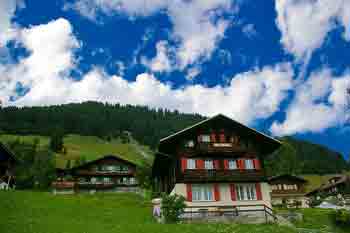
One challenge is that neither has an international airport so you’ll either be flying into Zurich or perhaps Geneva.
Train times from Zurich to Lucerne to Interlaken and back
- Zurich Airport to Lucerne: 1 hour 10 minutes by train
- Lucerne to Interlaken: 2 hours by train
- Interlaken to Zurich Airport: 2 hours 15 minutes by train
As you can see with the travel times above, Zurich Airport to Lucerne is a fairly short trip, but once you add Interlaken into the mix (even if you skip Lucerne) the travel time starts to add up for a weekend visit. With this in mind it’s probably best to just choose one of them and save the other one for another trip.
Lucerne is gorgeous, but the Lauterbrunnen Valley near Interlaken is really the star of the show, so I’d recommend going there first and doing Lucerne on another trip.
What about the Swiss Travel Pass?

The bottom line is that if you are coming to Switzerland for at least 3 days and you want to take 2 or more of the amazing scenic rail journeys that the country is famous for, the travel pass is probably a good deal. It also provides 50% discounts on the Schilthorn cable car and 25% off the Jungfraujoch mountain railway. Both of those are quite expensive on their own, but extremely worthwhile, so the discount is helpful.
The Half Fare Card is probably a better deal for most people
The Swiss Travel Pass is a good deal for those who are going to be spending at least 2 or 3 days riding the rails and seeing Switzerland that way. But if you are mostly going to be focusing on Interlaken and Lucerne and the mountain sights, the Half Fare Card is the best option. For CHF120 (about US$134) you get the card that is good for 30 days and gives you a 50% discount on all trains, cable cars, mountain railways, and other sights and attractions. If you are doing either Schilthorn or Jungfraujoch, the Half Fare Card practically pays for itself with just one of those.
>>>Buy the Swiss Half Fare Card
Many people have questions about the Swiss Half Fare Card so I will explain it a bit here. You can actually buy half price train tickets for travel within Switzerland any time you want and you will see that option when you go to buy them online. The only thing is you have to have and present a valid Half Fare Card when you get on the train and are asked to see your ticket. In other words, you can buy a half fare train ticket today and buy a Half Fare Card just before you get on that train months in the future, and you are fine.
How and why visit the area around Interlaken
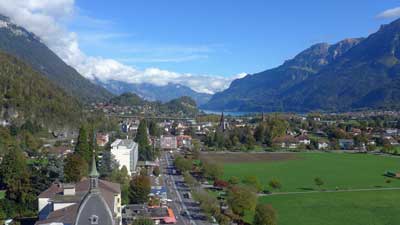
You can see everything discussed below by actually staying in a hotel in Interlaken, but it’s not the Alpine experience that you get if you stay in one of the small villages nearby. You can reach those villages in 20 to 40 minutes from the Interlaken Ost (East) train station, and it’s much easier than it sounds.
The 3 best places to stay to visit the Swiss Alps
Lauterbrunnen – A private train line runs from Interlaken Ost station to the end of its line in Lauterbrunnen. There’s a lovely waterfall here and great hiking trails, but you should probably only stay here if you can’t get to one of the villages mentioned just below. It’s a great little transit hub and it’s definitely gorgeous, so it can be worth a night if you’ve got one to spare.
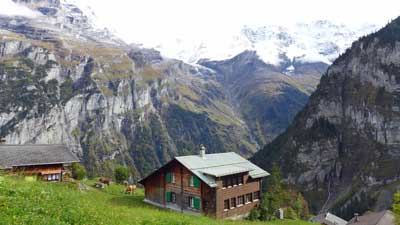
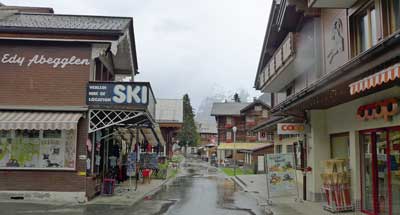
Where to stay in Interlaken and the Lauterbrunnen Valley (with pics)
I get so many questions about where to stay in the Interlaken area that I decided to write a longer version of it and load it with huge photos so readers can get a better feel for each option. I also included recommendations for affordable and well-located photos in each area.
>>>Where to stay in Interlaken and the Lauterbrunnen Valley New for 2024!
The unforgettable things to see here (if the weather is decent)
Schilthorn observation deck and restaurant
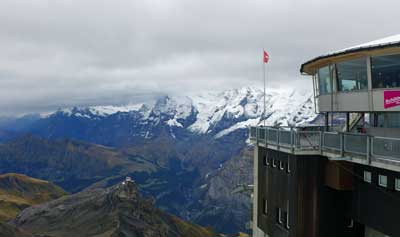
There is a rotating restaurant (with prices similar to normal Swiss restaurants) and a bizarre and anachronistic James Bond attraction based on it being a key location in the 1969 movie On Her Majesty’s Secret Service. The Bond thing is included with the lift, and it’s worth a look.
But the main thing you come here for is the 360-degree view from one of the highest peaks in Europe. Again, the weather here is key, but fortunately all the locals track the visibility on a minute-by-minute basis. If it’s clear up top while you are in the area, it would be a terrible shame to skip it based on the high price. But even if it’s cloudy up top, there are still plenty of wonderful things to see and do in the villages below.
Jungfraujoch observation area
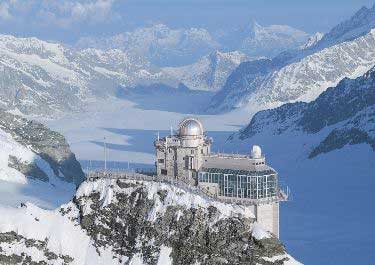
The views from the top are similar to the views from Schilthorn, from the other side of the Lauterbrunnen Valley. Once on top you can have lunch, hike, or even go sledding. It’s also quite expensive at nearly US$200 round-trip unless you have a Swiss Pass or a Eurail Pass for discounts, and it takes most of your day, but you’ll never forget the views from the top.
Harder Kulm mountain and Two Lakes Bridge Observation Deck
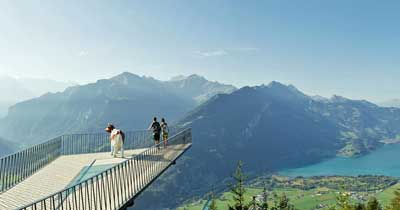
There’s a revolving restaurant about 10 minutes’ walk from the station at the top, which is definitely an unforgettable place for lunch if you’ve got time. It’s not as expensive as you might expect, at least compared to normal restaurants in Switzerland.
The Harder Kulm Railway goes from early April through late November each year. If you are only in Interlaken for one day and/or you are on a strict budget, this is the fastest and best way to get amazing Alpine views in the area.
Getting from Interlaken to Gimmelwald and Mürren
Getting up to these villages sounds complicated and time consuming, but it’s actually fast and easy once you get there. This little guide should help.
Arrive in Interlaken
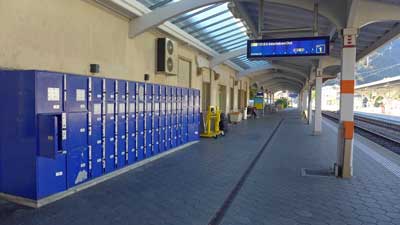
Once you arrive at the Interlaken Ost train station, head for the ticket windows in the office and buy a ticket to your final destination (Lauterbrunnen, Gimmelwald, or Mürren). Eurail passes are good for 25% discounts on the rest of the trip, but not for the whole thing.
From Interlaken Ost to Lauterbrunnen
The private train leaves Interlaken Ost every 30 minutes and arrives in Lauterbrunnen 20 minutes later. If you are staying in Lauterbrunnen then you are probably walking distance from your hotel when you reach the station.
From Lauterbrunnen to Gimmelwald
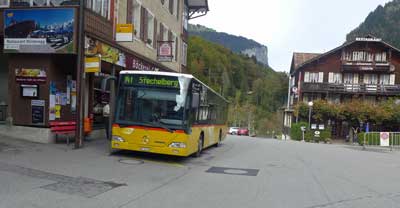

From
Gimmelwald to Mürren
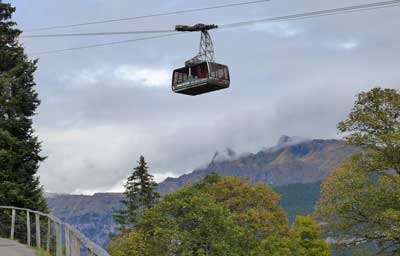
Recommended hotel and hostel in Gimmelwald
I get asked all the time about where to stay in Gimmelwald, so here it is:
Hotel: Esther’s Guesthouse
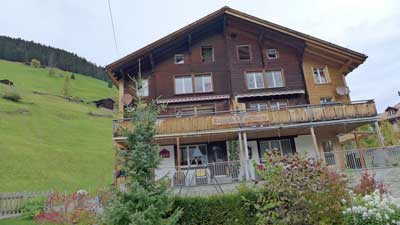
It’s run by Esther, as you might guess, and she is very friendly speaking excellent English. Each room is different and the place feels like a mountain cabin, because it is. She offers an excellent buffet breakfast in the morning, which you have to order the night before. It’s not cheap, but it’s worth it because it’s hearty and there are no other good options nearby.
Book as early as possible because this place is often the first place to sell out in Gimmelwald.
Hostel: Mountain Hostel Gimmelwald
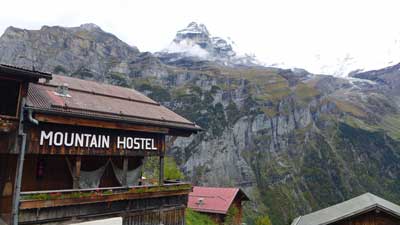
You won’t believe the views from this place, which are the same as from Esther’s except a bit lower and more unobstructed. This place also has a busy bar and restaurant that is basically the only “nightlife” in Gimmelwald. Many hikers get to bed early in this tiny village, but if you want to have a couple drinks and order a pizza or some local options, this is the place to go.
Again, book early because this place is always sold out.
Lucerne and what to do there
Luzern, as it’s spelled locally, is the other traditional holiday destination in Switzerland. Unlike Interlaken, Lucerne actually qualifies as a small city rather than a small resort town, so it’s a very nice contrast and very worthwhile. We have a new article with advice on where to stay in Lucerne and it should be helpful.
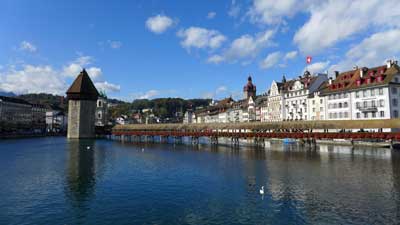
However, unlike Interlaken, the town of Lucerne itself is a great attraction and worth at least a day of exploration. This has always been a rich area so you can expect to find all of the high-end shops and boutiques along the small streets just north of the lake, but there are also many traditional shops and things to see that will appeal to anyone.
Recommended hotel in Lucerne
>>Hotel Des Alpes (3 stars with an amazing location and view)

If this place is booked, which is often the case, then book a hotel as close to it as you can find or afford. The whole historic part of town surrounding it is lovely, with restaurants, bars, and high-end shops. There are also a couple of nearby supermarkets where you can buy inexpensive alcohol and picnic supplies to keep other costs down.
Spend a day in Lucerne itself
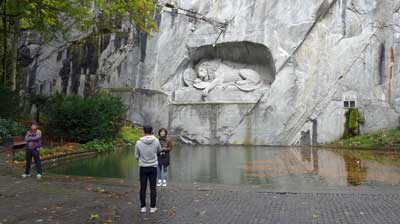
Most of the interesting part of Lucerne is in the area behind those restaurants, and it’s certainly worth doing a self-guided walking tour if not a guided one. Heading farther east you’ll come to another older part of town where the famous lion statue is located. You can’t visit Lucerne without having a look at the lion, and fortunately it’s easy and quick to reach (and it’s free).
Take a lake cruise of some kind
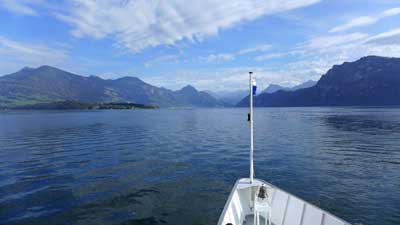
Especially in nice weather, even the short lake tour is lovely, and if you have more time you can jump off at Vitznau and do the scenic hike up Mount Rigi. There are also small lakeside villages that are ideal for a stroll and lunch stop. Long story short, there are dozens of interesting sightseeing options that are available using part of the boat tour, and the views all around are wonderful.
Visit Mount Pilatus
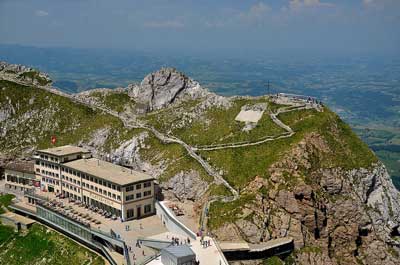
You can take the cogwheel train up and have a more or less flat hike around the summit area, and then take the gondola and cable car back down again. You can do them in the other order, and the cost is the same either way. At around US$65, this is not a cheap hike, but like most everything in Switzerland, the quality is high so it doesn’t feel like a rip-off. You can reach the cable car in 10 minutes on a public trolly bus from Lucerne.
Visit Mount Rigi
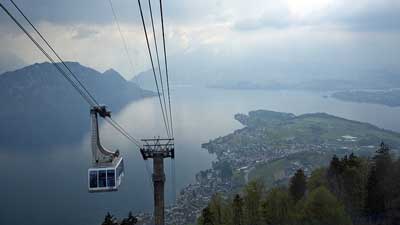
Unlike the other peaks mentioned in this article the Swiss Travel Pass covers both ways to get up and down for free. The others are 50% off with the Swiss Travel Pass or Half Fare Card, except for Jungfraujoch, which is only 25% off with the Swiss Travel Pass and still 50% off with the Half Fare Card.
Visit Mount Titlis
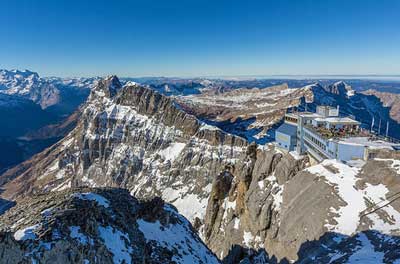
You can reach Titlis by taking a 43-minute train ride from Lucerne to Engelburg and then taking the cable car up from there. As with the others, it’s wise to check the weather immediately before you are going to depart because it can be foggy or cloudy any time of the year, but usually not for whole days at a time.
Additional photo credits
Jungfraujoch by cupweuro on Flickr, Pilatus by Tony Fernandez on Flickr, Rigi by Kosala Bandara on Flickr, Titlis by PaulSchliebs on Flickr

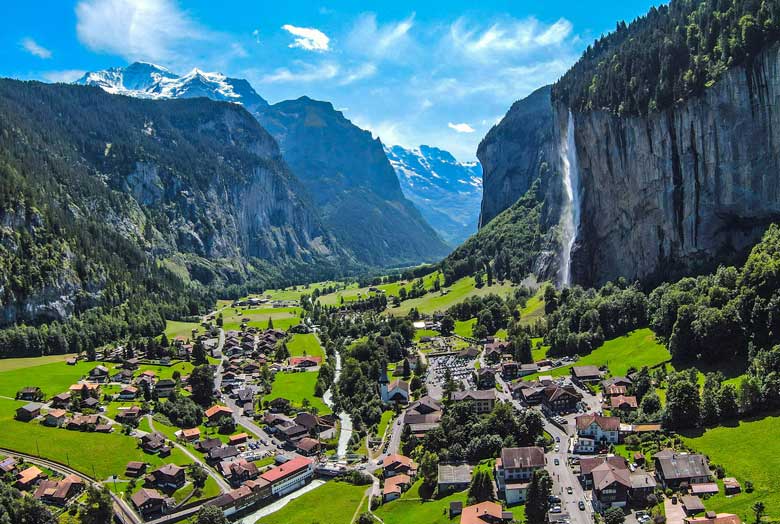
Hi Roger,
I can really do with some expert advice. I am travelling to Switzerland with my big family of 4 adults, 2 senior citizens, 1 infant and 2 children. This is our first visit to Europe. We have 9 nights in June. From the initial research we wish to cover Interlaken, Lucerne and Zermatt. might also take the train to milan and venice.. Could you help as to how many days would be good for each city? and exactly what should be done where?
Mohit,
If you want to include Milan I would probably only spend one day there, but I would probably skip it. If you went to Venice it’s best to only go for one or two nights, but it may not be worth the hassle to go to Venice for only a day or two. You might save Italy for another trip of its own. On the other hand, that train ride between Interlaken and Milan is wonderful and I’m sure you’d enjoy it at least in one direction.
As for Switzerland I would dedicate 3 days to Interlaken and probably 2 or 3 days for Lucerne. Interlaken has the most dramatic and famous sights, but Lucerne has plenty of great things of its own and they are all quite different from Interlaken, especially the boat cruise on the lake. Zermatt is a bit out of the way and getting there isn’t cheap. If you want to see the Matterhorn I would suggest two nights so you have one full day to go up one of the lifts and also have some time in the town. I really don’t like to make lists of things to do or see for people because it’s all so personal based on tastes, budget, and how fast people like to travel. All of the top sights are discussed in the article above, so if you choose the ones that sound most interesting to you I think you’ll be able to make a very good plan. I’m happy to help with specific questions if you have them while you are planning. -Roger
Hi Roger,
I did some more research after leaving above comment and there has been a slight change to my itinerary. Could you kindly have a look to see if below looks more reasonable?
25/5 – 28/5 London
28/5 – 31/5 Paris
31/5 – 3/6 Amsterdam or Brussels (haven’t decided which city to visit)
3/6 – 6/6 Prague
6/6 – 9/6 Interlaken (and other villages)
9/6 – 11/6 Rome
11/6 – 13/6 Venice
13/6 – 16/6 Florence
16/6 – Back to Rome and fly back to Sydney
I’m thinking if it is the easiest to catch the train between London, Paris and Amsterdam, and fly between Amsterdam, Prague, Interlaken and the train to Rome.
Thank you so much!
Mary Jane,
I obviously didn’t see this before I made the other comment. Amsterdam is far more interesting than Brussels, just as a start. But from Amsterdam to Prague the train takes 10 hours 20 minutes, so flying would be better (and the scenery is quite plain anyway). From Prague to Interlaken you’d also have to fly into Zurich and then take the train to Interlaken. Also, Florence is between Rome and Venice so it’s more efficient to start in Venice and end in Rome or vice versa. I prefer flying into Rome and then going north to Florence, Venice, and to Interlaken. I hope this helps. -Roger
Hi Roger,
Thank you so much for the great tips. I pretty much read through all your articles and gathered some thoughts but not sure if this is the best way to travel from Australia.
I have listed below cities for my first Europe trip and would like to get your advice on the itinerary.
I have not booked my flights yet so I can be flexible with in and out cities. I will be travelling in mid-May to early-June for 21 days.
Fly from Sydney to London (3-4 days in London)
Train from London to Paris (3-4 days in Paris)
Train from Paris to Amsterdam (3 days in Amsterdam)
Fly from Amsterdam to Rome (6 days in Rome and Venice)
Fly from Rome to Zurich/Geneva and train to Interlaken (4 days to travel around Interlaken, Lauterbrunnen, Gimmelwald and Murren)
Could you kindly have a look to see if I can map any better way to visit all cities and travel from/to Sydney?
If possible, I would love to squeeze in either Prague or Madrid/Barcelona by limiting 3 days to each city (which will give me extra 3 days) but I do not want to be too ambitious.
On another note, would you recommend booking few tours/day trips in each city? Given I will be travelling myself and it is my first time, I am considering if it will be easier to join tour groups.
Best Regards,
MJ
Mary Jane,
I think your route looks very efficient. The only change I would suggest is to fly from Amsterdam to Rome and then take the train to Venice. From Venice you can more quickly take a train to Interlaken (changing in Milan), and it’s an absolutely gorgeous train ride.
As for your allocation of days, it looks quite good. I would say that you could do Rome in 3 days and Venice in 1 or 2 days is plenty for most people (because it’s quite compact and also insanely crowded). Prague, Barcelona, and Madrid are all wonderful cities, but unfortunately none of them are on your route so you’d have to fly into one of them and probably fly out as well. Madrid and Barcelona are only about 2.5 hours apart by train, but they are both large cities with lots to see and do, and also quite different from each other, so I really don’t recommend spending fewer than 3 nights in either. It would be easier to work Prague in if you flew from, say, Amsterdam to Prague and then Prague to Rome. Still, that is quite ambitious and I would probably recommend staying with the places on your main list.
For solo travelers it can be great to book tours and day trips, but I wouldn’t book them in advance. I’ve spent literally 6 or so years traveling solo all over the world and very often those tours and day trips are mostly couples and families and groups, so they can be hit or miss for being sociable. The one thing more reliable for this is the free (tips-based) walking tours that are available in almost every major city these days. They all last from about 2 to 3 hours and they seem to attract quite a few solo travelers or at least travelers who are open to chatting with solo travelers. And the guides are always available for conversation as you are walking. Many of these walking tour companies also have pub crawls and other evening activities with small entry fees, and those can also be great for meeting other people. Let me know if you have any other questions. -Roger
Roger,
Your knowledge of Switzerland has been awesome. Thank you.
Would you mind taking a look at my basic itinerary please.
Day 1:
— 2:45 arrive Zurich airport and take train to Lucerne and spend night.
Day 2:
–1/2 to 1/4 day touring Lucerne and then head to Murren. Staying in Murren one night.
Day 3:
–All day exploring. Spend night in Interlaken.
Day 4:
— All day exploring. Spend night in Lucerne.
Day 5:
— Take early train to Zurich airport.
Any advice would be appreciated. Thank you.
SJ.
I’m happy to help. Your itinerary looks simple and well proportioned so I don’t really have any feedback. I think a Half Fare Card will probably save you money, and it looks like you have plenty of time to hit the main highlights in both of those areas. Have a great trip. -Roger
Hi Roger
Thank you for your article which has helped my wife and i get a rough plan on our visit to Switzerland.
We will be landing in Geneva on the 13th of March and intend staying in Switzerland for about 7-9 days ans then travel to Salzburg and Vienna .
In this time period, according to your article we would like to spend a few days in Lucerne and Bern . We just plan on having a relaxed holiday not too rushed with site seeing. Few days in the Mountains and Few days in Lucerne and Bern. How would be the best to get around ? i am planning on hiring a car as well or will this be superfluous ?
Next question is what would be best way to get to Salzburg Austria and then Vienna from Switzerland ? Excluding a flight .
Thank you
Kind Regards
Rajitha
Rajitha,
I’m glad to hear that this article was helpful. I would highly recommend traveling around by train in Switzerland rather than hiring a car of your own. Switzerland has excellent and famously punctual train service that goes everywhere you want to be. Also, while some towns you want to visit do have some available parking, many others don’t or charge very high prices for it. So parking a car of your own would be an issue, as opposed to just climbing aboard trains for each journey. It’s important to mention that train fares in Switzerland are quite high, but you can and should buy a Half Fare Card for CHF120 and that is valid for 30 days. Once you have that card you can use it for half-price tickets on all trains, cable cars, and even most lake cruise boats. Once you buy that Half Fare Card, which is discussed in my article on the Swiss Travel Pass, the train fares are quite reasonable. And better still, the Swiss trains are the best in Europe when it comes to comfort and punctuality.
To reach Austria you’ll also want to travel by train. From Zurich it’s about 5 hours and 20 minutes to Salzburg on a direct train with excellent scenery the whole way. From Salzburg to Vienna the train takes 2 hours 15 minutes, although it’s a bit less scenic. If you flew from Zurich or Geneva to Salzburg it would take at least that long when you accounted for airport transportation and security lines and all of that. And that 5-hour train ride will be very comfortable and very pleasant. You can buy that ticket on the main Swiss Rail website, and the earlier you buy the cheaper it will probably be. -Roger
Roger, I am glad we found this page. It has helpful information and is helping us to plan our summer trip this July to celebrate my husband’s 50 birthday. Could you please provide any recommendations/suggestions about the itinerary, best route, where to get train tickets in advance, places to stay, eat, etc.. Our itinerary is flexible and can be adjusted as needed. We like sceneries, architecture, churches, paintings and food.
Day 1: Arriving to Zurich in the morning (10am). Head to Lucerne. Where can we check train schedule and book train? We are planning to stay Hotel Des Alpes as suggested.
Day 2: Enjoy the day in Lucerne and head to Interlaken. Spend the night in Interlaken. Do you have any recommendation on where to stay?
We are getting the half fare card as suggested. Where is the link to get it?
Day 3: Visit Schilthorn if possible and stay in Murren as recommended. As you mentioned above, Esther’s Guesthouse is already booked.
Day 4: Head back to Interlaken to take a train to Milan. Spend the night in Milan. Since we only have one night, we are thinking to stay in Centro Storico to be able to visit The Last Super and Duomo. Is it possible to accomplish this in such a short time?
Day 5: Florence (do you have any recommendations, places to stay, must visit places?
Day 6: Florence
Day 7: Florence
Day 8: Lucca (do you have any recommendations, places to stay?)
Day 9: Lucca
Day 10: Siena (do you have any recommendations, places to stay?)
Day 11: Rome: This is our second time in Rome. We are thinking to stay in the Trastevere area this time)
Day 12: Rome
Day 13: Rome
Day 14: Venice (We stayed one night two years ago but it was not enough) do you have any recommendations on a place to stay?
Day 15: Venice
Day 16: Head to Zurich from Venice and stay in Zurich. Do you have a recommendation of where to stay?
Day 17: Head Home
Thank you in advance for any recommendations you can provide!
Andrea,
I think I covered most of this on the other comment, so I’ll just discuss the new points here. For all train transport in Switzerland you should visit the official Swiss rail site. It’s a bit confusing at first, but once you figure it out it seems easy. You can buy the Half Fare Card from the link on the page for the Swiss Travel Pass review. You can buy an electronic version of it that you can use immediately to buy half price tickets online. Or you can buy one when you get to Switzerland, but you might have to wait in a line depending on where you buy it.
It’s a shame that Esther’s Guesthouse is booked. That was the only hotel I stayed in, and I had dinner every night at the Mountain Hostel. Any hotel in Gimmelwald that is available and gets good reviews should be fine. The entire town is literally about 30 farms and a few hotels along a sidewalk that gently goes up towards Murren. In other words, all of them have pretty much the exact same amazing location.
Again, I would consider doing one day in Lucca and one day in Siena while staying in Florence. The famous main square in Siena is a fairly long walk from the train station, and it’s up a hill, although the first part can be done on a series of escalators. If you do stay in Siena I would try to find a place close to the main square rather than the train station.
For Venice I recommend staying on the main island and hopefully close to either St. Marks Square or the Rialto Bridge. It’s a small island and during the day it’s jammed with people on bus tours who arrive at 9am and leave again at 5pm. So if you are staying on the main island it will be almost empty in the mornings and evenings. It’s more expensive to stay on the main island, but in my opinion it’s definitely worth it to avoid the crowds. Let me know if you have any other questions. -Roger
Roger,
I am glad I found your page! Very helpful information. My husband and I are planning a trip to Switzerland and Italy this July. We recently booked a roundtrip to Zurich. Could you please make any recommendations about the itinerary, train pass, best train route? are we missing any other places we should visit instead? our itinerary is flexible.
We both love scenery, architecture, churches and food.
We are thinking to get the half fare card as recommended in your article.
Day 1 Arrive to Zurich (10am) and head to Lucerne
Day 2 Lucerne in the morning and head to Interlaken (spend the night in Interlaken)
Day 3 Stay in Gimmelwald, visit schilthorn and visit Murren
Day 4 Head to Milan and spend the night in Milan
Day 5 Florence
Day 6 Florence
Day 7 Florence
Day 8 Lucca
Day 9 Lucca
Day 10 Siena
Day 11 Rome ( We stayed in Rome 3 days two years ago. My husband wants to go back as he felt 3 days were not enough to explore Rome)
Day 12 Rome
Day 13 Rome
Day 14 Venice (we stayed in Venice 1 night two years ago and wanted to go back)
Day 15 Venice
Day 16 Head to Zurich from Venice
Day 17 Return home
We were initially thinking to visit Cinque Terre but will need to adjust our itinerary, we are flexible. Do you have any suggestions, adjustments? Thank you in advance for any recommendations and information you can provide.
Andrea,
Your itinerary looks very good and well thought out. Your stay in Switzerland seems a bit short, and you might consider adding another day or two and cutting back on Italy a bit, but I’m sure you’d enjoy it either way. Speaking of Italy, I haven’t been to Lucca yet, but I have been to Florence a few times and I spent 3 nights in Siena. Those less-touristy Tuscan towns such as Lucca and Siena are interesting, but they are also quite similar to Florence in many ways. Another way of doing this would be to find a comfortable place in Florence, perhaps an airbnb or some kind of apartment, and visit those other cities on a day trip. If you are staying reasonably close to the Florence train station (which is a convenient neighborhood in general, you could be in Lucca or Siena in about an hour and 20 minutes. You could visit the town squares and cathedrals and have lunch, and then jump back on the train back to Florence for the evening, without having to change hotels every day or two.
I would skip the Cinque Terre except maybe as a day trip. Those towns are now so crowded that summer visitors don’t really enjoy them anywhere near as much as they used to before they became so popular.
And I do think the Half Fare Card would be good value for you, and even a bit better value if you stayed another day or two. Have a great trip. -Roger
We will be briefly in Switzerland during the second week in April. Your advice given above has been instrumental in our planning. Interlaken will be our base and my question is regarding what type of shoes/boots would be best for walks in the Gimmelwald area? The high temperatures should be in the 40/50’s but will deeper treaded shoes be needed? We are not planning on major hikes, just enjoyable walks. Your posts have convinced us to add Schlithorn. Thank you for any information!
Hattie,
I’m happy this has helped. As for shoes, I don’t think you’ll need anything too special. For example, the trail between Murren and Gimmelwald is paved. Some of the other famous hikes in the Lauterbrunnen area, and especially those above Wengen, are on dirt trails, but they are very popular and well maintained. If you get unlucky and there is a rain storm before you go you might get some mud to deal with, but as long as you will be on the popular hiking routes you should have a fairly easy time of it. Switzerland is a rich country that puts a lot of money into providing a great tourist experience, and it really shows while you are there. Let me know if you have any other questions. -Roger
thanks Roger for the quick reply. thinking about heading to interlaken from Milan in 16 Feb 2018 what do you think is the best train route to take
Tony,
For train routes in Europe you usually only get one choice. If you request a ticket between those cities they will offer you a ticket on the fastest train, and fortunately that route is one of Europe’s finest for scenery. It will go from Milan to Spiez, and then you’ll change trains for the short ride to Interlaken. You should be able to buy this on either the Italy rail website or the Swiss rail website. Let me know if you have any other questions. -Roger
sir,
Been reading your posts here with interests. Im planning to visit Switzerland by way of Milan going possibly to Lugano. Is there to see in Lugano?
Tony,
I assume you were wondering if there is anything to see in Lugano? I’ve only passed through, but I do know that Lugano is mostly known for its wonderful lakeside scenery and its Italian culture. If you’ve heard of Lake Como in Italy, Lugano is the largest town in the area and it’s just over the hills from Lake Como so it’s very similar. People go there to relax and do a little shopping. It’s really beautiful, but there aren’t many real attractions. -Roger